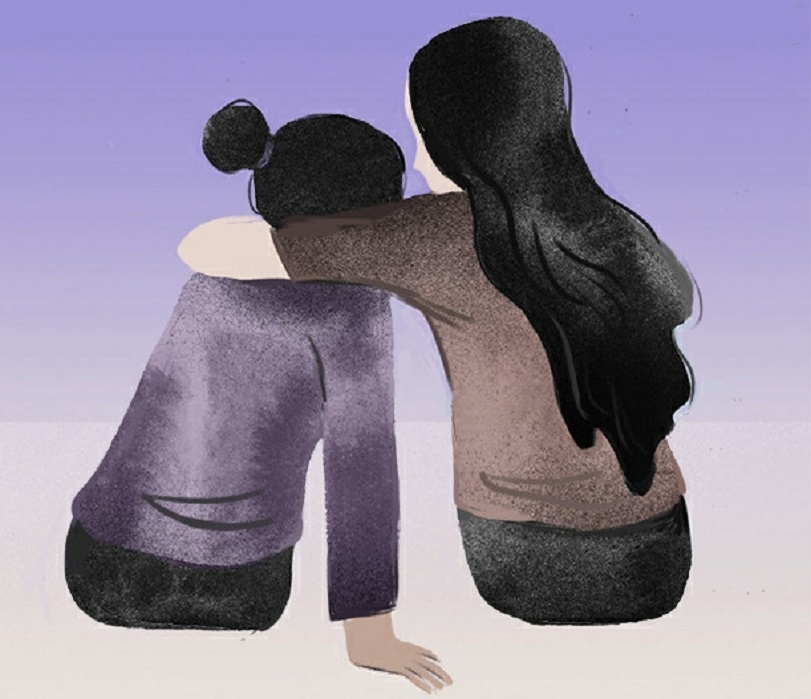
By Wasim Kakroo
THE International Society for the Study of Self-Injury defines Non-Suicidal Self-Injury as the deliberate, self-inflicted damage of body tissue without suicidal intent and for purposes not socially or culturally sanctioned. Self-harm is a symptom, not a diagnosis, of mental illness. Some people may do self-harm as a result of a mental illness such depression, anxiety, an eating disorder, or psychosis, however, self-harm isn’t always indicative of a mental illness, but rather of a lack of healthy coping methods to deal with emotions.
What to do if I have reason to believe that someone is self-injuring?
If you feel someone you care about is purposefully injuring themselves, you should talk to them about it. Recognize and address your own concerns about their self-harming behavior before approaching the person. If you’re unable to communicate with the person who is self-injuring, attempt to find someone else who can.
Identify a private space for the discussion about such behavior. Express your concern that the person may be harming himself or herself. Inquire about self-injury in a way that demonstrates to the person that you have some knowledge about self-injury so that they feel less judgmental, e.g., Say, “When people are in a lot of emotional distress, they sometimes harm themselves on purpose,”. Is that how you got your injury?”
Self-injury is a very personal issue that is difficult to talk about. Demanding that someone talk about something they don’t want to talk about isn’t a good idea. A strong emotional response such as anger, fear, revulsion, or irritation should be avoided while having a conversation with such person. If the person is having psychiatric treatment, find out if their treating professional is aware of the injuries.
What do I do if I find someone causing self-employed by self injuring?
If you have got engaged with someone who is committing intentional self-harm, intervene in a helpful and non-judgmental manner. When you learn that someone self-injures, it’s natural to feel disturbed, helpless, and even angry. Try to remain cool and avoid expressing shock or anger. Tell the person you care about them and ask if there is anything you can do to help them feel better. Inquire if medical assistance is required.
How do I approach someone who is deliberately Self-injuring?
Keep in mind that ‘stopping self-injury’ should not be the centre of the discussion. Instead, consider what can be done to make the person’s life easier or their environment less stressful. Recognize that self-injury cannot be stopped instantly, and that people will require time to recover and figure out healthy coping mechanisms.
Be helpful and non-judgmental in your behavior. Recognize that self-injury makes a person’s life less stressful and understand their motivations for doing so. Be supportive without condoning the behaviour. Be conscious of what your body language says about your attitudes towards self injury.
When speaking with the self injuring individual, use a cal voice. Avoid expressing frustration or a desire to punish the person for harming themselves. Allow the person time to comprehend what has been discussed by being available silently. Be prepared for strong emotions to be expressed by the self harming person.
What am I supposed to say?
Demonstrate concern and listen actively
When speaking with the person, use ‘I’ statements rather than ‘you’ statements (e.g., “I feel worried/angry/frustrated when you…” rather than “You make me feel worried/angry/frustrated…”). Inquire about the person’s self-injury, but don’t press them to talk about it. Recognize the person’s experience as they describe it to reflect what they’re saying.
Provide assistance and reassurance
Demonstrate empathy for the person’s feelings. Validate their emotions by telling them that their emotions are appropriate and valid.
Tell them they are not alone and that you are there to help them. Collaborate with the person to identify solutions (i.e., find out what they want to ensue and discuss any potential actions with them).
Reassure the individual that there are available sources of assistance and support. Inform the person that you wish to assist them and outline the methods in which you are willing to assist them.
Don’t pledge to keep the person’s self-injury a secret from them. Speak to them first, if you need to tell someone about a person’s self-injury in order to keep them safe. Avoid gossiping or discussing it with others without their permission.
Don’ts when dealing with someone who is self-injuring themselves:
Do not:
• Downplay the person’s feelings or difficulties.
• Make statements that dismiss the person’s suffering (for example, “but you’ve got a great life” or “things aren’t that awful”).
• try to address the person’s issues for them.
• Make physical contact with (e.g., hug or hold hands with) the person without their permission.
• Refer to the person as a ‘self-mutilator,’ a ‘self-injurer,’ or a ‘cutter.’
• Accuse the individual of doing self-injury to seek attention.
• Make the person feel guilty about the impact their self-harm is having on others.
• Make goals or pacts, such as “If you pledge not to damage yourself between now and next week, you’re doing incredibly well,” unless the person specifically requests you for it.
• Provide the individual with drugs, prescription medicines, or alcoholic beverages.
What should I do if the person is not willing to talk about it?
Respect the individual’s right to remain silent about their self-injury. If the person does not want to speak right away, tell them you will listen to them when they are ready. Inquire about what might help the person feel safe enough to talk about their feelings. Unless the injury is severe, do not press upon the matter. If the person still refuses to speak, seek assistance from a health professional on what to do.
How can I assist someone with Non-Suicidal Self Injury?
Seeking professional assistance
Self-injury is frequently a symptom of a treatable mental health disorder. Encourage the individual to seek professional assistance. Allow them to retain as much control over the decision of obtaining assistance as possible. Rather than telling the person what to do, suggest and explore choices for getting help. Assist the individual in developing a plan of action for getting assistance. Discuss how you can assist them in seeking therapy and who they can talk to, such as a mental health service or a mental health professional such as a clinical psychologist/psychiatrist.
Praise the individual on any steps he or she takes toward seeking professional help. Follow up with the person to see if they’ve found professional help that’s right for them.
You should seek mental health assistance on their behalf if:
• If the individual requests you to
• The harm is severe or getting worse, such as cuts getting deeper or bones broken
• The self-injurious behaviour is interfering with everyday living
• The person has caused damage to their eyes.
• The individual has caused injuries to their genitals.
• The individual has voiced a desire to die.
It’s important to remember that not everyone who self-injures wants to change their ways. Although you can offer assistance but you are not responsible for their conduct or behaviour and have no influence over what they do.
If the individual is a teenager, a more guided approach may be required. Assist the adolescent in developing a plan of action for obtaining help and offer to accompany them to an appointment.
When is it important to seek urgent medical intervention?
Don’t over-react; seek medical assistance from medical emergency services only if the harm is severe. Any gaping cut necessitates medical treatment, as it may require sutures. Any burn with a diameter of two centimetres or more, as well as any burn on the hands, feet, or face, necessitates medical treatment.
Call an ambulance if the person has hurt themselves by taking an overdose of medication or swallowing poison, as the risk of death or serious harm is significant. Deliberate overdose is usually intended to kill, although it can also be a form of self-injury. Irrespective of one’s intentions behind such acts, emergency medical help must be sought.
Alternates to Self-injury that should be encouraged
Since self-injury is an indication that the person has difficulty in handling their distress, encourage them to look for different ways to cope with their distress. Help the person employ coping mechanisms that do not need self-injury, and assist them in developing a plan for what to do when they feel like self-injuring. Recommend some coping skills and talk with the person about what would be beneficial to them.
Encourage them to utilise any good coping approach that helps them overcome the desire to self-injure. When the individual is distressed and has the temptation to self-injure, encourage them to communicate their feelings with others, such as a close friend or family member. Help the person consider strategies to alleviate their distress, such as taking a hot bath, listening to loud music, or doing something nice for oneself. Provide the individual with information materials (such as a website or leaflet) regarding alternatives to self-injury.
- The author is a licensed clinical psychologist (alumni of Govt. Medical College Srinagar) at Centre for Mental Health Services and can be reached at [email protected]
Follow this link to join our WhatsApp group: Join Now
Be Part of Quality Journalism |
Quality journalism takes a lot of time, money and hard work to produce and despite all the hardships we still do it. Our reporters and editors are working overtime in Kashmir and beyond to cover what you care about, break big stories, and expose injustices that can change lives. Today more people are reading Kashmir Observer than ever, but only a handful are paying while advertising revenues are falling fast. |
| ACT NOW |
| MONTHLY | Rs 100 | |
| YEARLY | Rs 1000 | |
| LIFETIME | Rs 10000 | |










